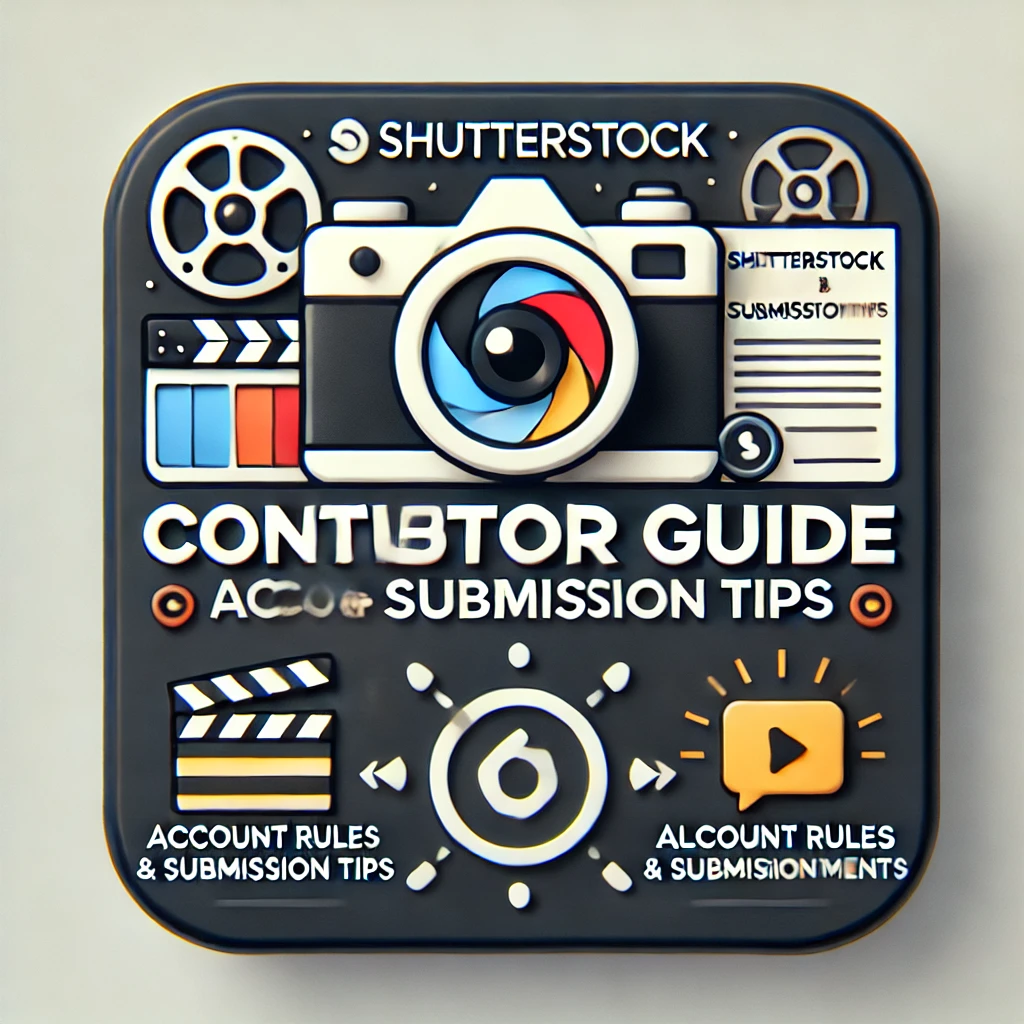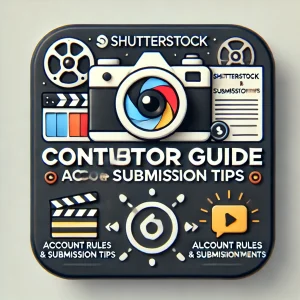Introduction:
Shutterstock is one of the world’s largest platforms for stock photography, illustrations, and video footage. With millions of assets available for licensing, it provides contributors the opportunity to earn passive income from their creative works. However, contributing to Shutterstock isn’t as simple as just uploading your content. There are stringent account regulations and content submission rules that contributors must follow to ensure compliance and successful participation.
In this guide, we will walk you through the account regulations, content ownership rules, submission policies, and content quality standards that every Shutterstock contributor should be aware of. By adhering to these guidelines, you can increase your chances of success on the platform and avoid penalties that might harm your account status.
Account Registration Requirements
Age Requirement: 18 Years and Older
To become a contributor on Shutterstock, you must be at least 18 years old. This is a universal requirement to ensure that contributors are legally able to enter into contracts and manage their accounts independently. For those under 18, a parent or legal guardian’s involvement is required to set up an account.
Restrictions on Account Sharing and Content Sharing
Shutterstock strictly prohibits the sharing of accounts between multiple individuals. Your account is personal, and only the registered contributor should have access to it. Sharing your account or allowing others to upload content through your account is a serious violation that can lead to suspension or termination.
Similarly, content uploaded to Shutterstock must be your original work or work you have the legal rights to submit. Sharing or selling content that belongs to someone else without their permission is not only a violation of Shutterstock’s policies but can also lead to legal consequences.
Business Account Creation Steps
For those who plan to contribute on behalf of a business, Shutterstock allows the creation of business accounts. However, this requires additional legal documentation. Businesses must provide proof of ownership, such as business licenses, tax forms, or other legal documents that verify the entity’s legitimacy. Business accounts allow for streamlined management of content and royalties, especially if multiple individuals are contributing under the same brand name.
Account Management Guidelines
Using Your Full Legal Name for Royalty Payments
Shutterstock requires contributors to use their full legal names when setting up their accounts, particularly for royalty payments. This ensures that payments are processed correctly and reach the right individual. Mismatches in account names and payment method names can cause delays or issues with receiving your royalties.
Limitations on Opening Multiple Accounts
Each contributor is allowed only one Shutterstock account. Opening multiple accounts under different names or identities to bypass Shutterstock’s policies or gain an unfair advantage is strictly prohibited. Contributors found violating this rule risk having all associated accounts suspended or permanently closed.
Payment Processing Guidelines
Shutterstock offers several payment processing methods, including Payoneer, PayPal, and Skrill. Contributors can choose their preferred payment method when setting up their accounts. The platform processes payments monthly, and contributors can withdraw their earnings once they reach the minimum payment threshold, which is currently $35. Ensure that your payment details are always up to date to avoid any interruptions in receiving payments.
Submission Policies
Consequences of Violating Submission Rules
Shutterstock enforces strict submission policies to maintain the quality and integrity of its content library. Violations of these rules can lead to warnings, suspensions, or even permanent account bans. Common violations include submitting plagiarized content, spamming keywords, or uploading irrelevant content.
Examples of Prohibited Behaviors
- Keyword Spamming: Overloading the metadata of your content with irrelevant keywords in an attempt to increase its visibility is against Shutterstock’s guidelines. The platform’s search algorithms penalize keyword spamming, and repeated offenses can lead to account suspension.
- Submitting Irrelevant or Low-Quality Content: Content that doesn’t meet Shutterstock’s technical requirements or is irrelevant to the platform’s marketplace will be rejected. Repeated submissions of poor-quality work can negatively impact your contributor rating and account standing.
Content Ownership and Intellectual Property
Copyright Regulations for Content Submissions
When you upload content to Shutterstock, you must own the copyright or have the legal right to distribute that content. This is crucial for avoiding copyright infringement and legal disputes. Shutterstock takes intellectual property violations seriously and will terminate accounts that are found to be in violation.
Guidelines for Submitting Content with Trademarks or Copyrighted Material
Contributors should be cautious when submitting content that includes trademarks, logos, or copyrighted material. If your content contains any identifiable brand names, logos, or products, you will need to obtain the necessary permissions from the trademark holder before submitting it for commercial use. If you do not have permission, this type of content should be submitted for editorial use only, where it can be used in news reporting or documentary work but not for advertising or promotional purposes.
Editorial vs. Commercial Use Content Submissions
- Commercial Use: Content intended for use in advertising, marketing, or promotions must be free of any trademarks, recognizable brand elements, or identifiable individuals (without a model release).
- Editorial Use: Content that includes trademarks, logos, or recognizable individuals can be submitted for editorial use, which is limited to newsworthy and informational purposes. These submissions cannot be used commercially but are valuable for publishers, journalists, and educators.
Content Quality Standards
Technical Requirements for Images and Footage
Shutterstock has specific technical requirements for both images and video footage:
- Images: Photos must be at least 4 megapixels and in JPEG format with a high level of clarity, sharpness, and appropriate lighting.
- Footage: Videos must be in HD or 4K resolution, properly exposed, and free from any significant defects like noise or pixelation. Shutterstock also expects contributors to use proper codecs for video compression and quality retention.
Failure to meet these technical requirements will result in content being rejected during the submission process.
Importance of Accurate and Non-Offensive Metadata
Metadata is critical for ensuring that your content is discoverable by potential buyers. When adding metadata to your submissions, it’s important to use accurate, clear, and relevant descriptions. Avoid using offensive or misleading terms, as these can not only alienate potential buyers but also violate Shutterstock’s community standards. Proper tagging and keywording ensure your content is placed in front of the right audience.
Guidelines for Submitting Diverse and Inclusive Content
Shutterstock encourages contributors to submit content that is diverse and inclusive. In today’s global marketplace, content buyers are looking for representations of different cultures, ethnicities, and backgrounds. Ensuring that your portfolio reflects diversity can make your content more appealing to a broader range of buyers.
Consequences of Violations
Overview of Warnings, Account Suspension, and Termination
Violating Shutterstock’s policies can result in various penalties, ranging from warnings to account suspension or permanent termination. Shutterstock operates on a three-strike system for minor infractions, meaning you will receive up to three warnings before any drastic actions are taken. However, serious violations, such as submitting plagiarized or stolen content, can result in immediate termination.
Steps to Take if You Receive a Warning
If you receive a warning from Shutterstock, it’s important to address the issue immediately. Carefully review the reason for the warning and correct any problems with your submissions or account. If the warning was a result of a misunderstanding or mistake, you can appeal the decision by providing Shutterstock’s support team with an explanation and any relevant documentation.
Conclusion
Adhering to Shutterstock’s account regulations and content submission rules is essential for a successful and long-lasting career as a contributor. Following these guidelines helps maintain the integrity of your portfolio, protects you from legal risks, and ensures that your work is discoverable and appealing to potential buyers. Shutterstock offers a tremendous opportunity for creative professionals to showcase their talent and earn income, but success on the platform requires diligence, professionalism, and adherence to the rules.
Call to Action: If you’re ready to start your journey as a Shutterstock contributor, make sure to familiarize yourself with the platform’s guidelines and follow best practices to maximize your success.












Hi, i believe that i noticed you visited my website so i came to “return the desire”.I’m trying to find issues to enhance my web site!I suppose its good enough to use a few of your ideas!!
I am continually invstigating online for tips that can facilitate me. Thank you!
Simply a smiling visitant here to share the love (:, btw great pattern. “Reading well is one of the great pleasures that solitude can afford you.” by Harold Bloom.
Rattling nice style and design and wonderful subject matter, very little else we need : D.
It’s hard to find knowledgeable people on this topic, but you sound like you know what you’re talking about! Thanks
Regards for this wondrous post, I am glad I noticed this internet site on yahoo.